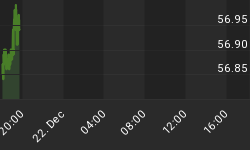Some observations in words and pictures on the equity markets.
Back on June 8, 2010, I presented some charts that offered up some technical signposts on the major indices. It was my feeling that we were getting some mixed signals that prevented me from making the call of a new bear market. In addition, my work showed that we were in the sweet spot for a turn around in prices, so until there was a price failure -- i.e., a break of support while sentiment was bearish (i.e., bull signal) -- the best course of action was to way in on the bullish side of the ledger.
Figure 1 is a weekly chart of the Ultra Short S&P500 ProShares (symbol: SDS). SDS is a 2x leverage product that inversely tracks the S&P500, yet is long only. Looking at figure 1, we note the key pivots. As you know, key pivots are those areas where buying (support) and selling (resistance) are most likely to take place. The key pivot point at 33.58 is identified, and for the first time in 5 weeks, it appears we will get a close below this level. This is bearish for SDS but bullish for the S&P500.
Figure 1. SDS/ weekly
Figure 2 is is the UltraShort QQQ ProShares (symbol: QID). This is a 2x leveraged product that moves inversely to the Nasdaq 100. With prices below the key pivot level at 18.49, this is bearish for QID, which is bullish for the Nasdaq 100.
Figure 2. QID/ weekly
On May 27, 2010, I mentioned the potential head and shoulders top forming on the S&P500. This notion is still on target as you can see in figure 3, a weekly chart of the S&P500. If I may speculate: 1) I can see this right shoulder forming over the next couple of weeks; 2) the market sells off sometime in September violating the neckline of this head and shoulders top; 3) CNBC declares a bear market; 4) prices reverse higher to close above the neckline and trade to the April, 2010 highs by the end of the year. I am not saying it will happen, but I it seems like a nice story to me.
Figure 3. S&P500/ weekly
There really is a lot of bad news out there, and a lot of uninspiring price action most of the time. It is hard to understand why there has been a persistent push higher over the past 2 weeks in the market. Short covering? Traders scooping up bargains? Investors previously on the side lines forced to chase prices higher? Wall of worry nonsense? All are possible. While the sell off that preceded the recent bounce was fast and furious, I contend that the damage done really didn't do much damage as major support levels were never really breached. In other words, investors really didn't dump their positions.
Looking at some aspects of the Rydex asset data - particularly the amount of money that left the market to the safety of the Rydex Money Market fund - we note that it really wasn't that great. In fact, the amount of funds in the Rydex Money Market never exceeded the levels seen in February, 2010. To me there just doesn't seem to be too much fuel on the sidelines to propel this rally higher. In essence, this fits in with my notion of a right shoulder forming as opposed to new highs being made. Of course, time will tell.















